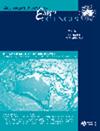The isotope geochemistry of host rocks of the late Archean Guandi and Banshigou banded iron formations, southern Jilin Province: temporal and tectonic significance
IF 0.9
4区 地球科学
Q3 GEOSCIENCES, MULTIDISCIPLINARY
引用次数: 0
Abstract
Abstract The Guandi and Banshigou iron deposits of southern Jilin Province, China, are Algoma-type banded iron formations (BIFs) located in the Eastern Block of the North China Craton (NCC). LA–ICP–MS U–Pb dating shows the magmatic zircons in plagioclase amphibolite from the Guandi BIF (PA–GD) and plagioclase hornblende gneiss from the Banshigou BIF (PHG–BSG) were crystallised at 2556 ± 17 Ma and 2545 ± 27 Ma, respectively, representing the formation age of the BIFs. Metamorphic overgrowth zircons from both samples gave two U–Pb ages of 2452 ± 23 Ma and 2446 ± 70 Ma, indicating the age of metamorphism. The zircon εHf(t) values of PA–GD (–1.3 to +2.8) and PHG–BSG (–1.5 to +2.7) indicate that the magma source was derived from depleted mantle with contamination of crustal material. According to our study, the PA–GD and PHG–BSG were formed in an island arc setting and support previously proposed subduction zone tectonic models for the northeastern NCC during the Neoarchean. KEY POINTS The magmatic zircons from the PA–GD and PHG–BSG were crystallised at 2556 ± 17 Ma and 2545 ± 27 Ma, which represents the formation age of the BIFs. The metamorphic overgrowth zircons from the PA–GD and PHG–BSG gave two ages of 2452 ± 23 Ma and 2446 ± 70 Ma, which represent the age of metamorphism. Major-element and REE data indicate that BIFs precipitated in a mixture of seawater and hydrothermal fluids in an anoxic environment. Geochemical and Hf isotope characteristics of BIFs’ wall rock indicate that the source magma was derived from a depleted mantle wedge metasomatised by subduction-slab melts and contaminated by ancient crust, formed in an island arc setting.吉林南部晚太古宙关帝、板石沟带状铁组寄主岩石同位素地球化学的时间和构造意义
摘要吉林省南部关帝、板石沟铁矿床是位于华北克拉通东部地块的阿尔戈马型带状铁组。LA–ICP–MS U–Pb定年显示,关帝BIF(PA–GD)斜长石角闪岩和板石沟BIF(PHG–BSG)斜长石角闪片麻岩中的岩浆锆石在2556年结晶 ± 17 马和2545 ± 27 Ma分别代表BIF的形成年龄。两个样品的变质过度生长锆石给出了2452的两个U–Pb年龄 ± 23 马和2446 ± 70 Ma,表示变质作用的年龄。PA–GD(-1.3至+2.8)和PHG–BSG(-1.5至+2.7)的锆石εHf(t)值表明,岩浆源来自受地壳物质污染的贫化地幔。根据我们的研究,PA–GD和PHG–BSG是在岛弧环境中形成的,并支持了先前提出的新太古代北卡罗来纳州东北部俯冲带构造模型。要点PA–GD和PHG–BSG的岩浆锆石在2556年结晶 ± 17 马和2545 ± 27 Ma,代表BIF的形成年龄。PA–GD和PHG–BSG的变质过度生长锆石给出了2452的两个年龄 ± 23 马和2446 ± 70 马,代表了变质作用的时代。主元素和REE数据表明,BIFs在缺氧环境中沉淀在海水和热液的混合物中。BIFs围岩的地球化学和Hf同位素特征表明,源岩浆来源于在岛弧环境中形成的被俯冲板熔体交代并被古老地壳污染的贫化地幔楔。
本文章由计算机程序翻译,如有差异,请以英文原文为准。
求助全文
约1分钟内获得全文
求助全文
来源期刊

Australian Journal of Earth Sciences
地学-地球科学综合
CiteScore
2.80
自引率
8.30%
发文量
45
审稿时长
6-12 weeks
期刊介绍:
Australian Journal of Earth Sciences publishes peer-reviewed research papers as well as significant review articles of general interest to geoscientists. The Journal covers the whole field of earth science including basin studies, regional geophysical studies and metallogeny. There is usually a thematic issue each year featuring a selection of papers on a particular area of earth science. Shorter papers are encouraged and are given priority in publication. Critical discussion of recently published papers is also encouraged.
 求助内容:
求助内容: 应助结果提醒方式:
应助结果提醒方式:


